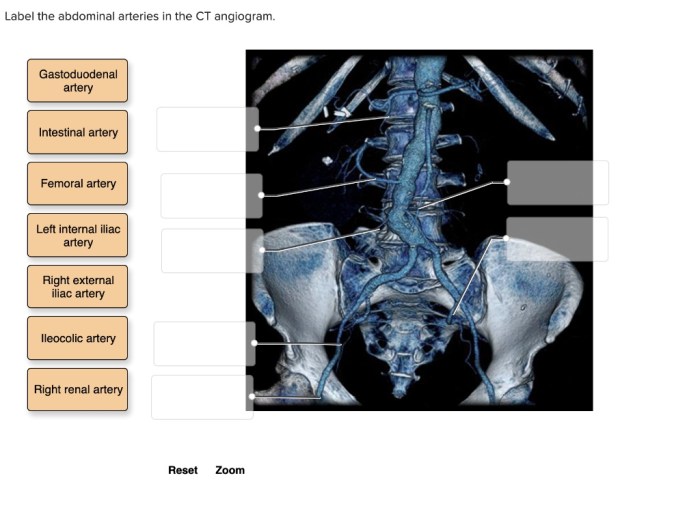Label the abdominal arteries in the ct angiogram – Labeling the abdominal arteries in a CT angiogram is a crucial step in medical imaging, providing valuable insights into the anatomy and potential pathologies of this region. This guide will delve into the location, course, and branches of the major abdominal arteries, equipping readers with a comprehensive understanding of this essential aspect of CT angiography.
The abdominal aorta, celiac trunk, superior mesenteric artery, inferior mesenteric artery, renal arteries, common iliac arteries, internal iliac artery, and external iliac artery are meticulously described, highlighting their anatomical relationships and clinical significance.
Abdominal Aorta
The abdominal aorta is the largest artery in the abdomen. It begins at the level of the diaphragm and ends at the level of the umbilicus, where it bifurcates into the common iliac arteries. The abdominal aorta supplies blood to the organs and tissues of the abdomen and pelvis.
Major Branches of the Abdominal Aorta
The major branches of the abdominal aorta include:
- Celiac trunk
- Superior mesenteric artery
- Inferior mesenteric artery
- Renal arteries
Celiac Trunk
The celiac trunk is the first major branch of the abdominal aorta. It arises at the level of the T12 vertebra and travels anteriorly to the stomach. The celiac trunk supplies blood to the stomach, liver, spleen, and pancreas.
Branches of the Celiac Trunk, Label the abdominal arteries in the ct angiogram
The branches of the celiac trunk include:
- Left gastric artery
- Right gastric artery
- Gastroepiploic artery
- Hepatic artery
- Splenic artery
Superior Mesenteric Artery
The superior mesenteric artery is the second major branch of the abdominal aorta. It arises at the level of the L1 vertebra and travels inferiorly to the small intestine and colon. The superior mesenteric artery supplies blood to the small intestine, colon, and pancreas.
Major Branches of the Superior Mesenteric Artery
The major branches of the superior mesenteric artery include:
- Inferior pancreaticoduodenal artery
- Jejunal arteries
- Ileocolic artery
- Right colic artery
- Middle colic artery
- Left colic artery
Inferior Mesenteric Artery

The inferior mesenteric artery is the third major branch of the abdominal aorta. It arises at the level of the L3 vertebra and travels inferiorly to the colon and rectum. The inferior mesenteric artery supplies blood to the colon and rectum.
Branches of the Inferior Mesenteric Artery
The branches of the inferior mesenteric artery include:
- Left colic artery
- Sigmoid arteries
- Superior rectal artery
Renal Arteries
The renal arteries are two arteries that arise from the abdominal aorta and supply blood to the kidneys. The renal arteries arise at the level of the L1 vertebra. The right renal artery is typically longer than the left renal artery.
Variability of the Renal Arteries
The renal arteries can vary in number and origin. In some cases, there may be only one renal artery, or there may be more than two renal arteries. The renal arteries may also arise from different levels of the abdominal aorta.
Common Iliac Arteries

The common iliac arteries are two arteries that arise from the bifurcation of the abdominal aorta. The common iliac arteries travel inferiorly and laterally to the pelvis. The right common iliac artery is longer than the left common iliac artery.
Branches of the Common Iliac Arteries
The branches of the common iliac arteries include:
- Internal iliac artery
- External iliac artery
Internal Iliac Artery
The internal iliac artery is the main artery that supplies blood to the pelvis. It arises from the common iliac artery and travels inferiorly and medially. The internal iliac artery supplies blood to the pelvic organs, including the bladder, rectum, and reproductive organs.
Branches of the Internal Iliac Artery
The branches of the internal iliac artery include:
- Superior gluteal artery
- Inferior gluteal artery
- Internal pudendal artery
- Umbilical artery
- Obturator artery
External Iliac Artery: Label The Abdominal Arteries In The Ct Angiogram

The external iliac artery is the main artery that supplies blood to the lower limb. It arises from the common iliac artery and travels inferiorly and laterally. The external iliac artery supplies blood to the thigh, leg, and foot.
Branches of the External Iliac Artery
The branches of the external iliac artery include:
- Inferior epigastric artery
- Deep circumflex iliac artery
- Femoral artery
Common Queries
What is the most common variation in the anatomy of the renal arteries?
The most common variation is the presence of an accessory renal artery, which occurs in approximately 20% of the population.
What is the clinical significance of labeling the internal iliac artery?
Labeling the internal iliac artery is important for preoperative planning of pelvic surgeries, as it supplies blood to the pelvic organs.
How does the superior mesenteric artery contribute to digestion?
The superior mesenteric artery supplies blood to the small intestine, cecum, and ascending colon, playing a crucial role in the absorption of nutrients.